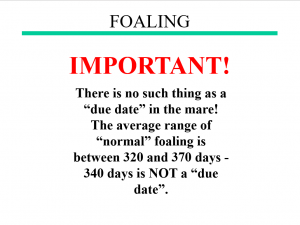
When lecturing on equine reproduction our lead lecturer Jos Mottershead often comments that there are several words to lose in order to avoid confusion and – plainly – being incorrect. The words he always cites are “never” and “always”, because the moment that one uses those words, invariably someone in the audience comes up with a situation which clearly demonstrates the opposite. In short, there are really no absolutes in the world of horse breeding.
At this time of the year, Jos frequently increases the list of words to lose, and is sometimes seen to be increasingly grumpy – particularly in places such as the EquineRepro Facebook Group which we created and operate (the largest dedicated group, with over 30,000 members worldwide!) where he posts regularly – when that word (or perhaps more correctly “phrase”) is used. What is this addition to the list of words to lose – “Due Date“!
In our equine reproduction mare short course we have a slide which always produces a combination of nods and surprised looks throughout the attendees. It reads “There is no such thing as a ‘due date’ in the mare!” The confusion is often driven by the concept that in the human, there is a fairly narrow window of normal gestational duration, and people always want to try and transfer known facts with which they are comfortable in the human to the equine, but – particularly in this case – that often doesn’t work. Ironically, even in the human, there is an acknowledged range of normal gestation of between 38 to 42 weeks1 and that has been shown in research to perhaps be even longer with a 37 day variability in some instances2, but we digress… The equine then, has a far wider range of “normal gestational duration”, generally recognized as being anywhere between 320 and 370 days. Prior to 300 days in a “regular” mare (Miniature Horses have a rulebook of their own and do not conform to this), the neonate will rarely be viable, even with Intensive Care assistance. This is often in part due to lack of lung maturation. Between 300 and 310 days, there will be a variable level of survival, greatly dependent upon the availability of Neonatal Intensive Care facility or services. At 310 days, survival rates increase, but often NIC is still required. By 320 days, one can start to breathe more easily, as survival rates dramatically increase at that point, as the gestational duration has reached the “normal” stage.
 At the other end of the duration – beyond 370 days – it is worthy of note that there will still be a high percentage of successful live foal production. In fact, in our article about “overdue mares“, a poll we ran for many years showed over 20% of pregnancies which resulted in a live foal were longer than 370 days in duration. In fairness, we should consider that this poll was related to an article about longer gestational duration, so it is quite likely that some people who initially reviewed it as a result of having a mare “go long” returned later to add their data, but it is still an important reminder that there are a high percentage of “long” gestations in the equine which end successfully.
At the other end of the duration – beyond 370 days – it is worthy of note that there will still be a high percentage of successful live foal production. In fact, in our article about “overdue mares“, a poll we ran for many years showed over 20% of pregnancies which resulted in a live foal were longer than 370 days in duration. In fairness, we should consider that this poll was related to an article about longer gestational duration, so it is quite likely that some people who initially reviewed it as a result of having a mare “go long” returned later to add their data, but it is still an important reminder that there are a high percentage of “long” gestations in the equine which end successfully.
So are there concerns about those mares which “go long”? As a general rule, if endophyte exposure has been ruled out (Fescue grass etc.), it is usually simply a matter of the mare – or more precisely the foal, as it’s the foal which initiated the foaling process – not being ready yet. Often, foals born to mares with long pregnancy durations are smaller than might be anticipated for that particular cross. This is important to remember, because one concern often voiced is that the foal could “grow too large for the mare to easily birth”. Typically, the size of the uterine environment controls the size to which the foal will grow in-utero3, so this is rarely a problem.
So, along with “never” and “always” as words to lose “due date” must also rank highly when discussing the equine! Make sure you lose those words, and – along with suitable monitoring of your pregnancy and close-to-term mare – your stress levels related to foaling will decrease appreciably!
References:
1: National Library of Medicine
2: Jukic A.M., Baird D.D., Weinberg C.R., McConnaughey D.R., Wilcox A.J. 2013. Length of human pregnancy and contributors to its natural variation. Hum Reprod. 2013 Oct; 28(10): 2848–2855.
3: Allen W.R., Wilsher S., Turnbull C., Stewart F., Ousey J., Rossdale P.D., Fowden A.L. Influence of maternal size on placental, fetal and postnatal growth in the horse. I. Development in utero. 2002. Reproduction 123(3):445-53.
© 2023 Equine-Reproduction.com, LLC
Use of post permitted only upon receipt of required permission and with necessary accreditation.
Please contact us for further details of post use requirements.
Other conditions may apply.



